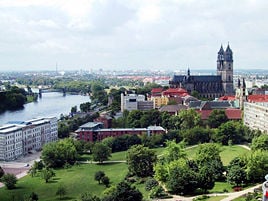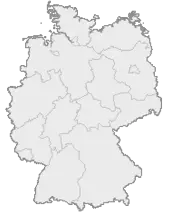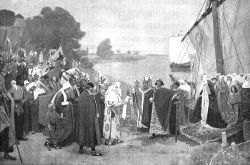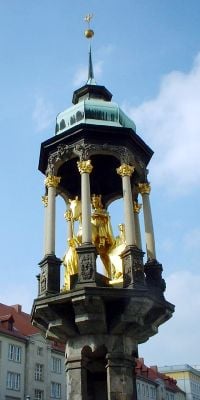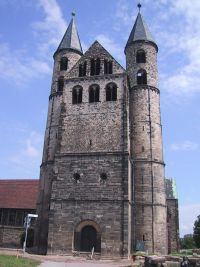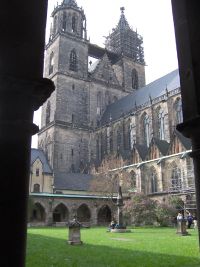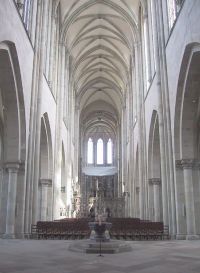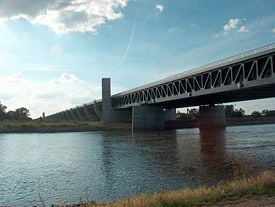Magdeburg
Magdeburg, the capital city of the Bundesland of Saxony-Anhalt, Germany, was one of the most important cities of medieval Europe. Situated at a natural crossroads on the Elbe, it possessed a strong defensive position. Throughout its colorful history, Magdeburg has been subjected to devastation and destruction, particularly the Sack of Magdeburg in 1631, in which the city was engulfed in flames and the majority of its inhabitants were smothered in the cellars and granaries where they had taken refuge. The city also enjoyed frequent periods of prosperity. The current town landscape includes architectural monuments dating from its various historical periods. Though much of the city was again destroyed during World War II, beautiful cathedrals and monasteries remain, for which the Magdeburg is famous. Magdeburg's most significant role in history is as the site of Martin Luther's early teachings. The Reformation found speedy adherents in Magdeburg, which quickly became a stronghold of Protestantism. The city became known among Protestants as "The Lord God's Chancellery." HistoryThe city of Magdeburg first entered the written record as a fortified town of emperor Charlemagne. In order to defend against Hungarian and Slavic invaders, the small fishing village was quickly transformed into an extremely strong defensive position. Later emperors, such as King Henry I, also followed the trend and chose Magdeburg as a defensive position. The fortress was given to Edward the Fowler's daughter, Edith, as a wedding present. According to historical records, Edith loved the city so much that she chose to be buried in the parish churchyard. From its early legacy as a military fortress, Magdeburg became a center for religious study around 900 C.E. At this time the Archbishopic of Magdeburg was founded, facilitating the rise of Magdeburg as a religious power. Adalbert of Magdeburg received the archbishopship, effectively gaining control of the Havelberg, Brandenburg, Merseburg, Meissen, and Zeitz-Naumburg. Probably due to its rising significance in the religious scene, Magdeburg was granted a patent to hold trade exhibits and conventions in 1035. As a result of this patent, Magdeburg combined its rising religious authority with economic clout, becoming a major urban center in early Germany. Despite the promise of Magdeburg, nearly all dreams nearly came to a crashing halt in 1118 when a fire ravaged the city. Luckily, Magdeburg was able to recover from the effects of the fire, and joined the Hanseatic League in the early thirteenth century. It is important to note that, even after the debilitating fire, Magdeburg was counted as one of the cities with a population numbering over 20,000 inhabitants in the Holy Roman Empire. 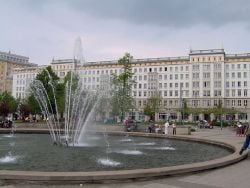 Magdeburg's center has numerous Stalinist neo-classicist buildings. As a major rising metropolis, Magdeburg soon attracted a series of religious dissidents who sought the large audiences of an urban center. One rising dissident, Martin Luther, was attracted to the rising urban center, and began to lecture in the city in 1524. Almost immediately, he gained a large gathering of followers, and soon drew the attention of Emperor Charles V. The young preacher was seen as a challenge to the authority of the church, and the city was repeatedly outlawed by the religious authorities. At the time that encapsulated the church's resistance to the unconventional ideas of Magdeburg, the city was besieged from 1550 to 1551 by the emperor’s troops. Resistance to imperial power, which was coupled with official religious ideology, Magdeburg maintained its religious and political independence. Due to the military resistance of the emperor’s invasion, Magdeburg gained a worldwide reputation as a center for religious tolerance and Protestant religious growth. To celebrate their new religious freedom, Magdeburg soon published the writings of the dissident, while politically disavowing, Martin Luther. Luther felt that the Catholic Church had become corrupt, and had lost sight of its religious ideals. The independence of Magdeburg soon began to falter, as the religious city could not maintain its ideological independence in the face of political threats. The first blow to strike Magdeburg, the Thirty Year's War, pitted the military strength of Magdeburg against the troops of the Holy Roman Empire. The Empire's forces eventually triumphed, committing a massacre with the imperial troops killing 20,000 inhabitants of the city. After the devastating struggle of the war, it is reported that only 400 individuals remained in the city. The political power of Madgeburg was completely destroyed as a product of the war, and the city was given to Brandenburg-Prussia in the treaty of Westphalia. The Napoleonic Wars were also detrimental to the independence of Magdeburg, as the city was quickly surrendered to French troops. After the Napoleaonic War, Madgeburg was made capital of the new Kingdom of Prussia, and while politically important, was not autonomous. World War II was devastating to the small urban city of Magdeburg. Many of the historical buildings were destroyed, and the city suffered extremely large population losses. Allied firebombing, a new technique at the time, guaranteed that the city remained virtually uninhabitable after the war. By most reports it is stated that the damage to Magdeburg was second only to Dresden in matter of devastation. Partially due to the fact that Magdeburg was completely devastated during the war, the rebuilding of the city was seen as a matter of nationalistic pride after the war. Following German reunification the new, and rebuilt, Magdeburg became capital of the newly formed state of Saxony-Anhalt. CathedralThe historical and religious legacy of Magdeburg is best epitomized by the Magdeburg Cathedral, which can be traced to 937 C.E. At that time, a small abbey named St. Maurice, stood at the site of the modern cathedral. The abbey fell victim to one of the frequent fires in Magdeburg, and was leveled in 1207. To replace the fallen abbey, the creation of a cathedral was begun in a nearby location. After nearly 300 years, a fully formed cathedral called the Cathedral of the Saints stood as a testament to the church's influence on the lives of the inhabitants of Magdeburg. The main feature of the Cathedral is a statue of St. Maurice that shows him with African features. In choosing to represent the African heritage of St. Maurice, the church departs from the traditional method of representing the saints. The statue is considered one of the earliest depictions of an African person in the art of Europe. Another scandalous feature of the art in the Cathedral of the Saints is the statue of St. Catherine, which also departs from idealized images of the saints by depicting her in modern clothing. Additional historic sitesMagdeburg's rich history is recorded in its architecture and monuments.
GeographyGeographically, Magdeburg is situated on a large flat plain, with much of the city lying along the left bank of the Elbe River. Structurally, Magdeburg consists of the main city hub, with five large suburbs nearby. The five suburbs: Friedrichstadt, Wilhelmstadt, Neustadt, Sudenburg and Buckau are separated from the city proper; especially Wilhelmstadt, Neustadt, Sudenburg and Buckau that are divided from the main urban center by a series of geographic grooves that were cut into the earth during glacier movements. The city, and the suburbs, are distinguished by small, windy streets that wind throughout the city. The only exception to this rule is Breite Weg, a large road that runs directly north from south through the main center of town. The weather of Magdeburg is extremely variable regarding temperature and rainfall. While the temperatures can dip as low as 32° Fahrenheit in the winter months, summers can be sweltering. When the temperatures reach 80° Fahrenheit, rainfall also increases in the area, rising to a high of approximately eight inches a month. Rainfall and the heat combine to make the summer months particularly difficult for outdoor activities. For this reason, the tourist season in Magdeburg runs from early fall to early winter. EconomyThe industry of Magdeburg is heavily based on large scale industrial exportation. Key industries in the area include sugar refining and chicory production, both of which take place on an extremely large industrial scale. Smaller industries include tobacco production, chocolate production, and varnish formulation. Like many cities in Germany, Magdeburg also boasts a variety of distilleries and breweries. In matters of agricultural production, Magdeburg produces a large variety of cereals, fruits and other vegetables. In addition, Magdeburg hosts large herds of cattle and horses. Wool, cloth, and leather are key exports in regards to textiles. Magdeburg continues to be a large export economy to the modern day, a fact that is supported by a recently constructed man-made harbor. The new winter harbor, built to facilitate traffic along the Elbe, is estimated to process roughly three million tons of merchandise a year. Magdeburg Water BridgeThe 918-meter Magdeburg Water Bridge (Wasserstrassenkreuz in German), completed in October 2003, is a bridge that connects two important German shipping canals, the Elbe-Havel Canal and the Mittellandkanal, which meet near Magdeburg and lead to the country’s industrial Ruhr Valley heartland. It is the longest water bridge in Europe. Engineers first conceived of joining the two waterways as far back as 1919, and by 1938 the Rothensee boat lift and bridge anchors were in place, but construction was postponed during World War II. After the Cold War split Germany, the project was put on hold indefinitely by the East German government. With the reunification of Germany and the following establishment of major projects in transport tracks the Water Bridge again became a priority. Construction began in 1997 and was completed in six years. References
|
||||||||||||||||||||||||||||||||||||||||||||||
